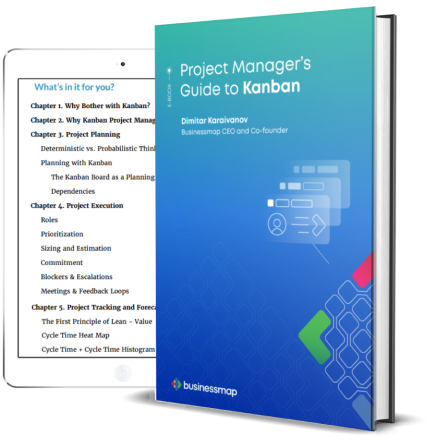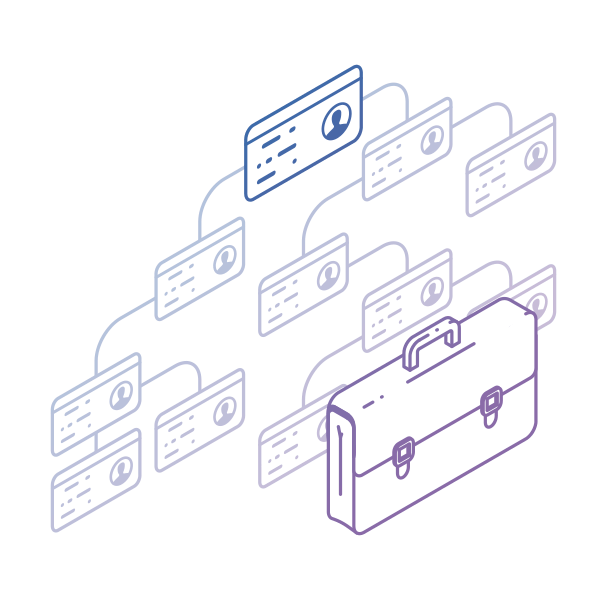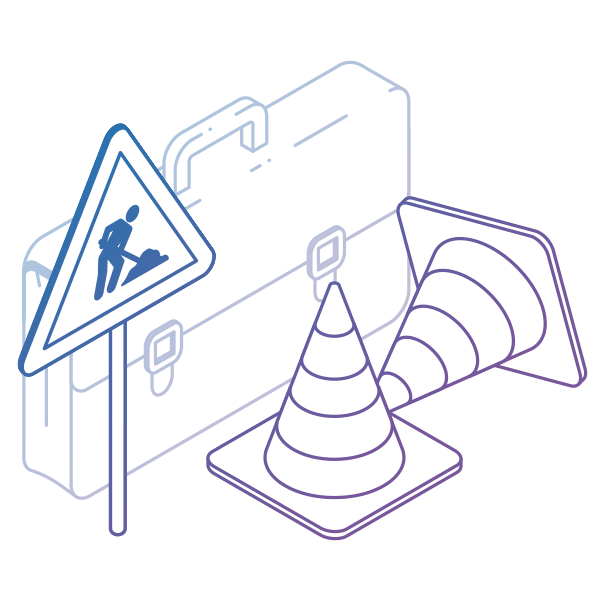Project and product roadmaps are among the most important artifacts that every project or product manager has to provide so that key stakeholders are kept informed. However, the way most professionals build roadmaps today is broken.
The minute someone believes they can predict the future and provide a detailed estimate of the individual work item level, a lot of damage is done. If we plan that something will start on a given date and finish on a given date, we start fooling everyone, including ourselves.
If you ever have to foresee the future, the Portfolio Kanban concept can be employed so that you deliver a flexible, lean, Kanban roadmap that will actually help.
What Is a Kanban Roadmap?
First thing first, let’s set the ground for what a kanban roadmap is.
A Kanban roadmap is a visual planning and work management tool used in project management and product development to outline and track the progress of initiatives, features, or tasks. It combines the principles of a traditional roadmap, which provides a high-level view of strategic goals, with the Kanban method, which focuses on visualizing work, managing flow, and improving processes.
Challenges with Traditional Roadmap Implementations
The real problem with traditional roadmaps is that they are deterministic, often communicating fixed dates and scope, while they should be probabilistic, communicating that there is an X percent probability to deliver certain scope by a given date.
Have you ever seen a product roadmap with milestones set on a given date? How often do you see any probability attached to this date? Right, hardly ever. This is a real challenge for many companies because project and program managers work with fixed dates.
However, when you talk about the future, and you are in the knowledge work business, nobody knows how long things will take. Therefore, you must never communicate fixed dates and milestones unless you are 100% certain that you can do it.
If you are required to communicate fixed dates, just because nobody would ever consider your bid for the project, then do what you have to do to win it. This will most likely require that you commit to delivering a certain amount of work for a certain period of time.
Good or bad, that’s how the world works today, and that’s normal. However, the fact that you commit to a fixed date doesn’t require executing your project in a waterfall manner. You can still have a flexible roadmap within the specified boundaries.
What’s the Way Out? Portfolio Kanban and a Kanban Roadmap.
Before digging into the depths of the Portfolio Kanban application for Kanban Roadmap implementations, let’s scratch the topic of Upstream Kanban, otherwise known as Customer Kanban.
Upstream Kanban / Customer Kanban
As Patrick Steyaert explains in the article “Customer Kanban – from customer push to customer pull”, Upstream Kanban (Customer Kanban) is:
Upstream Kanban visualizes the demand in terms of options explored to define and select the work items that will be committed.

Everything else aside, thinking in terms of options is critical to getting to a better understanding of how a Kanban Roadmap works. All non-started projects are options visualized as Kanban cards on your Kanban board's “Requested” area. Even if a given project is committed, unless it’s been started, it’s still an option that you can choose to execute or not.
Treating non-started work as optional is, in fact, deferring the commitment to the latest responsible moment. This is one of the Lean Software Development principles that Tom and Mary Poppendieck discuss in one of their popular books. This principle holds true not just for software development but for any knowledge work.
If you defer the commitment, then you can choose to descope certain pieces of work, should the circumstances require it. If you operate based on a predefined master plan, then you lose this flexibility. Even if you don’t need this flexibility, it may be useful because you will learn new things as the project progresses. You can use this new knowledge to postpone some of the features and expedite others. Therefore, the ability to reorganize your plan in a quick and unobtrusive manner can lead to great economic benefits.
How to Implement Portfolio Kanban Roadmap?
If you are not familiar with the term Portfolio Kanban, please go through this article before you continue reading further: What is Portfolio Kanban?.
To realize a Kanban roadmap, first, you need to have a Portfolio Kanban board. This board will usually hold MMFs (Minimal Marketable Feature) or Projects. The MMFs or Projects will be broken down into User Stories or, simply put – tasks.
10 Years Kanban Experience In 1 Free Book.
Project Manager's Guide to Kanban
With the Kanban board in place, you need to focus on the leftmost part of the board – the Requested area (the one with the grey line at the top). The Requested area contains items that have not been started yet (options). Based on your project scope and timeline, you can add an unlimited number of columns to the Requested area, which, in this scenario, represents a reversed timeline.
Take a look at this sample image:

As shown above, the rightmost column in the Requested area is the closest one to the present moment (This Month). The farther you go to the left, the more you go into the future – “Next 3 Months”, “Unplanned”. Naturally, the items that you put in these columns should get planned for the corresponding period.
For example, all the items in the “This Month” column should be expected to finish before the end of the month. All work items in the “Next Three Months” should be expected to finish in the next three months, etc.
When it comes to priority, the higher an item is within the column, the higher its priority is. If you want to re-prioritize, drag, and drop the item to its new position.
The columns' names can vary as per your convenience, as long as they indicate a reversed timeline. In the example above, we used months, but in your case, it could be days, weeks, months, quarters, or even years. The horizontal lanes can be used for different teams, products, or whatever else makes sense in your context.
As simple as it may be, this is what a simple Portfolio Kanban Roadmap looks like.
The Pros and Cons of the Portfolio Kanban Roadmap
There are a few major advantages to implementing a Kanban Roadmap using a Portfolio Kanban Board. We list them below for your review.
What are the Benefits of a Portfolio Kanban Roadmap?
-
Gives Visual Clarity – The visual nature of the Kanban roadmap allows you to grasp a lot of information easily. The Kanban roadmap is an excellent information radiator because everyone can see it and instantly answer the question “When is X going to be done?” without the need for status reporting.
-
Easy to Re-prioritize – As mentioned above, changing the priority is as simple as dragging and dropping the card to a new position. This is how you make sure that the teams will only work on the most important items first.
-
Easy to Change Due Dates – What should you do if due dates change? Well, instead of updating a three-year plan, all you need to do is change the column of some of the items. Of course, this activity requires careful analysis around capacity and throughput, but we have something to help you there as well: Portfolio Kanban – How To Forecast on the Portfolio Level.
-
Easily Extend and Change - Given the structure of a Kanban board, we can always add columns to the left and label them “Next 3 months”, “Next 6 months”, “Next Year”, etc. This gives us a great visual representation of what’s coming further down the line without us digging into estimations and too much detail.
-
Detecting and Resolving Blocks - When options flow through the Portfolio Kanban board, we can spot when a given option is stuck for too long in a given state. This gives us control over the situation and allows us to unblock it before it’s too late.
-
Thinking and Working in Options - We can cancel an option anytime, as long as it is not started. Note that we can still cancel an option if it’s executed (started), but that would be a waste of time and resources, so we should restrain from doing it often.
-
Supports Flow on the Global Level – Probably the most important piece is that your Kanban roadmap is not a static PowerPoint presentation that nobody looks at. On the contrary – it is a living entity that constantly broadcasts information and enables flow across the organization. With this approach to road mapping, you won’t just say when things will get done, but you’ll be able to monitor if they are on track actively and what is still left to be done. This gives you the freedom to escape from red/green/yellow reporting and embrace the flow metrics, such as cycle time and flow efficiency at the portfolio level.
What Are the Disadvantages of a Portfolio Kanban Roadmap?
The only real disadvantage to the Kanban roadmap is the lack of fixed dates. Technically speaking, you could label a column with a certain date and treat it as a milestone, but this more or less violates the flow-based approach described above.
Businessmap is the most flexible software
to align work with company goals
In Summary
This concept represents a different paradigm and needs changes in perspective to get started and get used to. However, once you’ve managed your first project this way, you are not likely to look back at the old ways.











